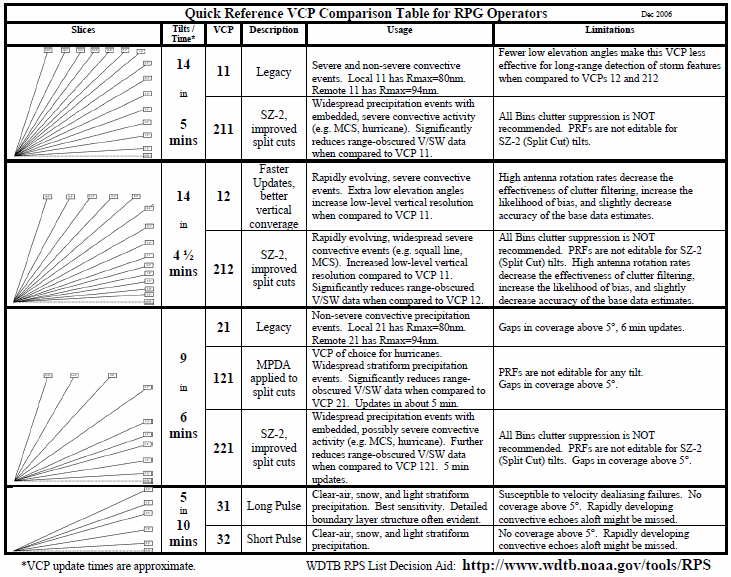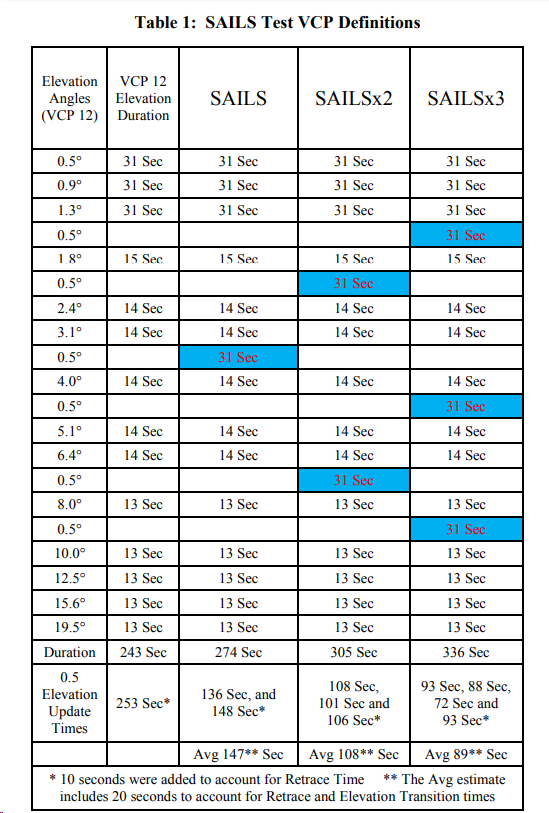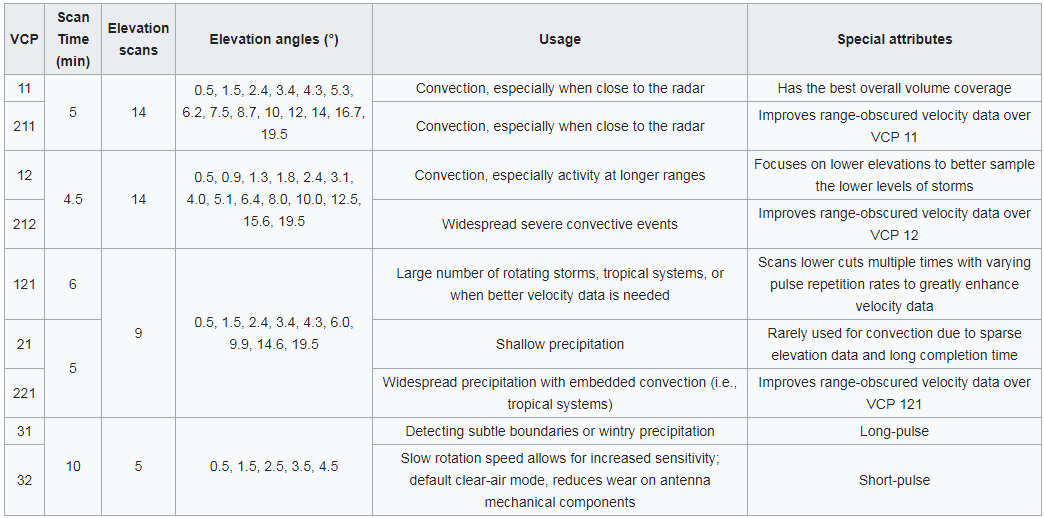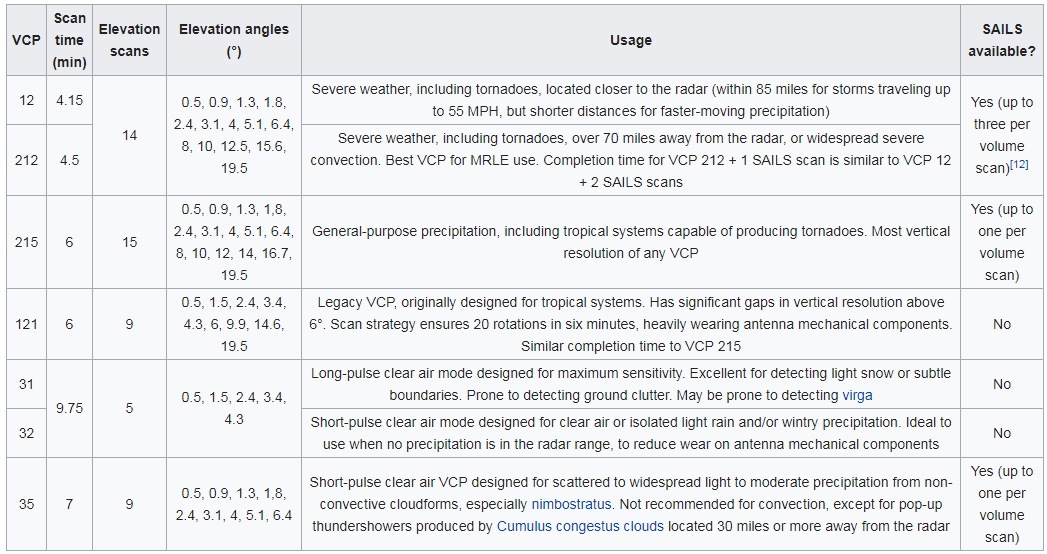(in progress)
Unlike older radars where the radar operator could directly control the environmental scanning pattern of the antenna, including performing vertical or horizontal scans, NEXRAD has a variety of fixed so-called Volume Coverage Patterns (VCPs) that it uses to interrogate the environment.
A Volume Coverage Pattern or VCP is a set of instructions that controls various aspects of NEXRAD antenna functioning including the rotation rate, Pulse Repetition Frequency (PRF), pulse duration, and the elevation angles, to maximize the information-gathering for different weather situations. Recent years have seen modifications introduced to provide more frequent updates for the lowest 0.5 degree elevation angle in response to forecaster demand.
NEXRAD VCPs are described in detail in the Federal Meteorological Handbook 11 FMH-11-Part C WSR-88D Products and Algorithms--Chapter 5 . Also see more updated info from the Jetstream Online Meteorology School on VCPs.
VCP Classification and Naming Convention
VCP names consist of 2 or 3-digit numbers starting with 1, 2, or 3.
There currently are 11 total VCPs--8 for the precip. mode, and 3 for the clear-air mode.
Over the years the number of VCPs has increased from the original 4 (two clear-air and two precip. mode). These changes are summarized in an online document from October, 2015 by the Radar Operations Center (ROC):
"The WSR-88D was initially fielded with 4 Volume Coverage Patterns (VCPs). Two of the
original VCPs (VCP 32 and VCP 31) were dedicated to Clear-Air observations and have
exceedingly long dwell times, allowing a very low signal-to-noise ratio. These two VCPs have
identical scanning angles (see Table 1) but employ different pulse lengths. The other 2 VCPs
(VCP 21 and VCP 11) were designed for detecting, tracking and analyzing precipitation and
severe weather signatures. The major differences between the precipitation VCPs are the
scanning rates and the elevations scanned above 4.5 degree elevation (see Tables 2 and 3).
The initial suite of two precipitation VCPs has since been expanded to seven. First, responding
to field request for faster updates, VCP 12 (see Table 4) was introduced with its overlapping
low-level elevation angles and fast rotation rates as a significantly better severe weather
interrogation alternative. Then SZ-2 processing was added to the three operational precipitation
mode VCPs and VCPs 212, 211 and 221 were fielded. Finally, these VCPs were complimented
by VCP 121, a version of VCP 21 that was specifically designed for observing
Hurricanes/Tropical Storms and widespread precipitation events."
In an earlier version of FMH-11, 7 VCPs were identified: 3 precipitation mode groups covering 5 VCPs and one clear-air mode group of 2 VCPs. Later, two more VCPs were added for a total of 9. Then, sometime after 2015, two additional VCPs were added to replace some of the legacy VCPs: VCP 35, an additional clear air mode VCP, and VCP 215, a general surveillance precipitation mode VCP meant to replace some of the legacy VCPs, but bringing the current total to 11.
It is unclear from the online literature whether all VCPs are still be available; a brief two-day informal sampling from the following two web pages that show which VCPs are being used at any given time have indicated VCP 211 not being used.
https://www.roc.noaa.gov/WSR88D/Operations/VCP.aspx
and
https://wdssii.nssl.noaa.gov/web/wdss2/products/radar/systems/w2vcp.shtml
The following "Quick Reference VCP Comparison Table for RPG [Radar Product Generator] Operators" from the NWS Warning Decision Training Division (WDTD) summarizes VCP characteristics. The "legacy" VCPs have been superceded by the three-digit VCP's which use more sophisticated processing to reduce range-folding in the velocity data; sometimes these "legacy" VCP's are still used anyway.

- Deep Convection Group: Two digits beginning with
1, VCP 11 and 12. [Now also VCP 211 and 212]
- Shallow Precipitation Group: Two digits
beginning with 2, VCP 21. [Now also VCP 221]
- Multiple PRF Dealiasing Group (MPDA): Three digits beginning with 1, VCP 121.
- Clear-Air Group: Two digits beginning with 3, VCP 31 and VCP 32. [after 2015 includes VCP 35]
- General Surveillance: VCP 215
Additionally, in recent years modifications
to pre-set scanning have been implemented:
AVSET (Automated Volume Scan Evaluation and
Termination) provides early termination of scans only at
elevation angles above 5 degrees if no precipitation data
are detected at the higher angles (why waste scans looking
at nothing?), yielding shorter duration VCPs, and therefore
more rapid updates. According to the WDTD, AVSET was
fielded in 2011.
SAILS
(Supplemental Adaptive Intra-volume Low-level Scan)
inserts an additional 0.5 degree elevation split-cut scan
into severe weather VCPs 12 or 212 or general surveillance
VCP 215 between higher level scans doubles the update rate
for the lowest-level (0.5 degree) scans. SAILS was
fielded during 2014.
MESO-SAILS
(Multiple Elevation Scan Option for Supplemental Adaptive
Intra-Volume Low-Level Scan) inserts two additional
split-cut scans for SAILS2 operation and three for SAILS3
operation into
severe weather VCPs 12 or 212 or general
surveillance VCP 215 between higher level scans
for even more frequent lowest-level scans. It can
yield updates at 0.5 degrees on average every 89 seconds,
and even faster when combined with AVSET. MESO-SAILS
was deployed during 2016. The following table shows
the additional scans for SAILS and MESO-SAILS:

genesis region (4000 to 8000 ft AGL layer) within Quasi-Linear Convective Systems (QLCS). Scheduled to be included for non-operational testing in RPG Build 18 and made operational with RPG Build 19.
The Warning Decision Training Division identifies a Range Folding Mitigation Group -- VCPs 121, 211, 212, and 221 are in this group.
The Multiple PRF Dealiasing Algorithm (MPDA) is part of VCP 121 processing. MPDA reduced range folding by processing additional Doppler rotations at lower elevation angles.
The Sachidananda-Zrnic (SZ-2) technique is implemented for the lower two or three elevations for VCPs 211, 221, and 212. When echoes are overlaid, SZ-2 can usually recover velocity data for two of the overlaid range bins. SZ-2 is also used for one of the Doppler rotations at 0.5 and 1.5 degrees with VCP 121."
According to the Wikipedia NEXRAD page the following table contains the current VCPs, while the second table below contains changes to be implemented during 2018. Some of those changes (e.g. VCP 35 and VCP 215) have already been implemented.

2018?

-------------
The WSR-88D initiates data aquisition in the Clear-Air Mode and automatically switches to Precipitation Mode when it detects precipitation above a certain threshold. It can also be manually switched to precip. mode.
WSR-88D Sampling Terminology:
Split Cut--scans a particular elevation slice two or more times using a different PRF for each full scan. Used for the lowest elevation angles (those below 1.65o) where efficient clutter suppression is required and velocity range folding is likely.
Contiguous Surveillance (CS)--The low PRF scan of the split cut. Gives a high Rmax value to determine proper target location and intensity, but a low Vmax value limits the velocities that can be measured.
Contiguous Doppler (CD)--The high PRF scan of the split cut. Gives a low Rmax value causing more range folded (multiple trip) echoes, but a high Vmax value to get higher, more accurate velocity values.
Batch Mode--uses alternating low and high PRFs on each radial for one full rotation at each elevation angle. The two resulting data sets (low PRF and high PRF) are combined to resolve range ambiguity. Used in the middle elevation angles.
Contiguous Doppler X (CDX)(or Contiguous Doppler with no range unfolding)--combines a high PRF and a rapid antenna rotation rate to obtain all base data in the higher elevation slices > 7o). Does not need to maximize the range since, for example, at 7.5o the radar beam is already at an elevation of ~50,000 feet at 62 nm range from the radar.
Sachidananda-Zrnic (SZ-2) Split Cut (SZCS/SZCD) (quoted from Warning Decision Training Division training materials)
SZ-2 is a different range unfolding technique applied to the Split Cuts of VCPs 121, 211, 212, and 221. SZ-2 is able to reveal far more velocity data compared to the other range unfolding technique. Details on both of these techniques are presented in later sections of Topic 3.
NOTE: As with the standard Split Cut mode,
dual-polarization base data are processed from the SZ-2
Contiguous Surveillance rotation.
Multiple PRF Dealiasing Algorithm (MPDA)
(quoted from Warning Decision Training Branch training
materials)
The MPDA is implemented solely by invoking VCP 121. Though
MPDA is not a waveform, it uses a unique combination of
the SZCS, SZCD, CS, CD, and B waveforms. In the lower
elevations of VCP 121, there are multiple Doppler
rotations at each angle, each of which uses a different
PRF.
Illustration of the elevations angles scanned and
waveforms used during VCP 121.
Figure 21: Volume Coverage Pattern (VCP) 121 samples nine
elevation angles in about 5.75 minutes. The lowest two
angles apply the SZ-2 technique as part of MPDA, the
lowest five angles apply the MPDA technique, while 6.0 deg
uses Batch (B), and the higher angles use Contiguous
Doppler without range unfolding (CD/WO) mode.
As an example, the link below shows an animation of VCP 11, originally from the Warning Decision Training Branch:
VCP 11 Animation -- Click on "Actual" to see the actual rotation rate of the beam in real time.
Brief description of VCPs.
Volume Coverage Pattern Quick Reference Guide